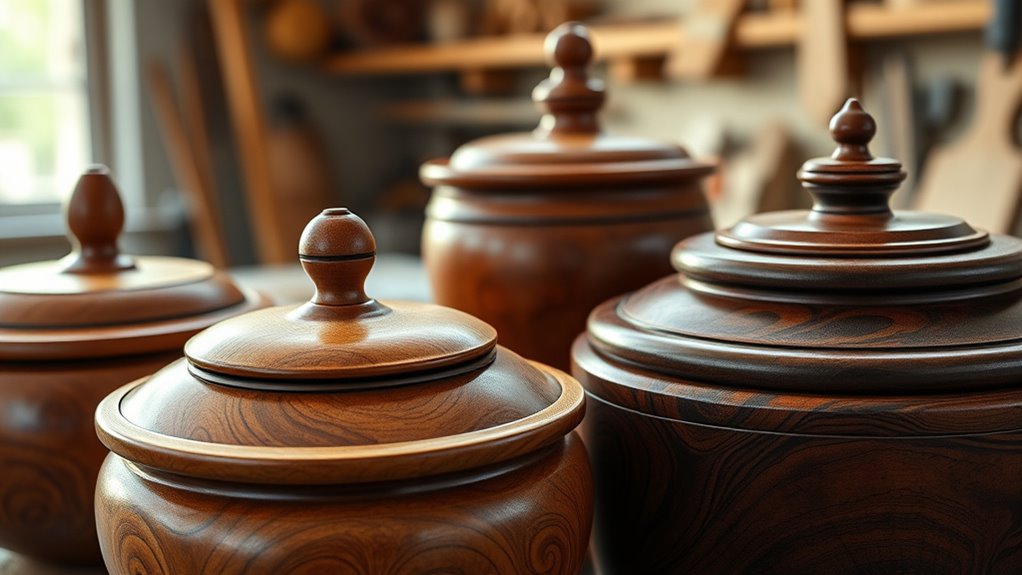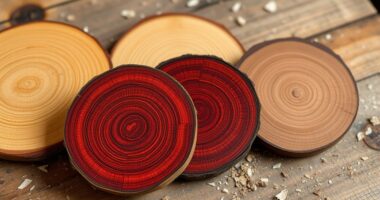To master advanced turning of hollow forms and lidded boxes, focus on shaping exterior surfaces first, then carefully hollow out interiors with long-reach cutters or boring bars. Achieve precise fit for lids by measuring carefully and maintaining tight tolerances. Use refined finishing techniques, including fine abrasives and polishing, to create smooth surfaces and sharp edges. Always prioritize safety with secure workpieces and sharp tools. Keep these tips in mind, and you’ll uncover even more ways to elevate your craftsmanship.
Key Takeaways
- Use long-reach cutters and boring bars to create precise hollow forms with smooth, uniform interiors.
- Measure carefully for lidded boxes to ensure a snug, secure fit between the lid and base.
- Employ meticulous finishing techniques, including sanding and polishing, to achieve smooth surfaces and sharp edges.
- Maintain safety by securing workpieces firmly, using sharp tools, and operating at controlled speeds.
- Support delicate pieces with live centers or tailstocks and regularly clear debris to ensure stability and safety during finishing.

Have you ever wondered how skilled machinists achieve precise, complex shapes in metal? When it comes to advanced turning, creating hollow forms and lidded boxes demands both technical mastery and an eye for detail. These projects push the boundaries of traditional turning, requiring you to employ refined finishing techniques to guarantee smooth surfaces and sharp edges. Finishing isn’t just about aesthetics; it also improves the functionality and durability of your work. You’ll often use fine abrasives, polishing compounds, and meticulous sanding to eliminate tool marks and surface imperfections. As you progress through these stages, it’s crucial to pay close attention to safety considerations. Sharp tools, spinning workpieces, and high-speed operations can pose risks if proper precautions aren’t taken. Always wear eye protection and avoid loose clothing that could get caught in the machinery. Securing your workpiece firmly in the chuck is critical to prevent slips or accidents during delicate finishing passes. Additionally, understanding copyright vs. trademark differences can help protect your original designs from infringement once your project is complete. When turning hollow forms, you start by carefully shaping the exterior, then proceed to hollow out the interior with specialized tools like boring bars or long-reach cutters. This process requires steady hands and precise control to maintain even wall thickness and avoid thinning the metal excessively. For lidded boxes, you’ll craft a snug-fitting lid, which involves fine measurements and sometimes the use of live centers or tailstocks for support. Achieving a perfect fit depends on careful finishing techniques—sanding and polishing the mating surfaces to eliminate gaps or rough edges. During these steps, safety considerations become even more essential. Ensure your tools are sharp and properly maintained, as dull tools can slip and cause injury or damage your workpiece. Also, work at a controlled speed; high rpm can increase the risk of accidents and produce heat that may compromise your tool’s integrity. Throughout the entire process, keep your workspace clean and organized. Debris and swarf can obscure your view or cause slips, so regularly clear away shavings and dust. Use appropriate protective gear, including gloves when handling finished parts, but avoid gloves near rotating machinery. Always double-check your setup before starting a finishing pass, as a stable, secure workpiece is key to safety and achieving high-quality results. By combining meticulous finishing techniques with vigilant safety practices, you’ll produce stunning hollow forms and lidded boxes that are both beautiful and functional, showcasing your skill and attention to detail in advanced turning projects.
Frequently Asked Questions
What Tools Are Best for Hollowing Delicate Forms?
For hollowing delicate forms, you should select tools like hook knives, curved gouges, and hollowing tools designed for precision. These tools allow you to control your hollowing techniques effectively, minimizing the risk of breakage. Use long, slender tools for reaching into tight spaces and maintain steady, controlled cuts. Proper tool selection is vital for achieving smooth, even walls without compromising the integrity of fragile, intricate shapes.
How Do I Achieve Perfect Symmetry in Lidded Boxes?
Achieving perfect symmetry in lidded boxes feels like balancing a tightrope walk, but precision measurement and symmetry techniques make it manageable. You start by carefully measuring the lid and bowl diameters, then use calipers for exactness. Centering tools and marking gauges help guarantee alignment. Regularly check your work from different angles, adjusting as needed. With patience and precise tools, you’ll create a beautifully symmetrical lidded box that feels effortless.
What Safety Precautions Are Essential for Advanced Turning?
When doing advanced turning, always wear protective gear like safety glasses and a dust mask, and make certain your workspace is well-lit and free of clutter to prevent accidents. Keep your tools sharp and properly maintained, and stay focused on your work to avoid injuries. Never rush, and make sure your lathe is securely mounted. Prioritizing workspace safety and protective gear keeps you safe as you create intricate hollow forms and lidded boxes.
How Can I Prevent Wood Splitting During Hollowing?
To prevent wood splitting during hollowing, you should control moisture content by drying your wood properly before turning. Keep your tools sharp to make clean cuts, reducing stress on the wood. Use appropriate tool techniques, like gentle, steady cuts, and avoid over-hollowing areas. Regularly check the wood’s moisture level, and consider sealing the inside to prevent uneven drying, which can cause splitting.
Which Wood Species Are Ideal for Fine Lidded Boxes?
You should consider woods like boxwood, ebony, and rosewood for fine lidded boxes, as they lend themselves beautifully to intricate finishing techniques and decorative inlays. These woods offer a smooth, dense surface that’s easy to work with and hold detail well. Their stability minimizes cracking, ensuring your craftsmanship shines through. By choosing these species, you create elegant, durable boxes that showcase your skill and attention to detail.
Conclusion
Now that you’ve mastered hollow forms and lidded boxes, you’re truly pushing your turning skills to new heights. Think of each project as a blank canvas, waiting for your creative touch to transform it into art. Remember, every swirl and carve is a step toward mastery—your journey is the brush, and the wood, your canvas. Keep turning, keep dreaming; because in this craft, the only limit is the sky waiting to be carved out of wood.









